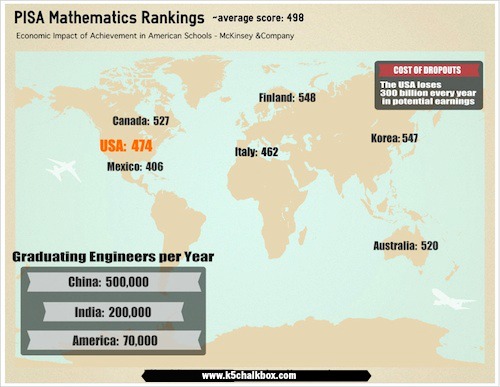Top ten things you need to know about teaching gifted students. These kids are special and we have to do a better job in educating them.
The research on teaching exceptional students is clear: we aren’t doing a very good job of it.
Federal funding for education statistics shows that unless a state or district applies for funds through the Jacob K. Javits Gifted and Talented Students Education Act of 1994, no money is given to the education of gifted students.
There is no national policy in the USA to provide an appropriate education for these kids either. Although funds are given to the National Association for Gifted Children to research and develop best practices, that money is not seen by schools.
The statistics on teaching gifted students show that at least 60% of all teachers – right now – have never had a class or any training in gifted education.
And no matter how much support we are given, the majority of the teaching has to come in the regular classroom setting.
But we must do a better job of it. Korea, Switzerland and Finland have as much as 5 times the top performers in math than the United States. The March 2006 report from the Gates Foundation stated that over 80% of high school dropouts did so not because of poor grades…they were bored.
It is up to us to turn this around in the only way we can until things begin to improve as a nation: by reaching our students within our classrooms.
Top Ten Tips for Teaching Gifted Students
These are my top strategies for working with gifted children. I have taught many of them over the years and one of my son’s is highly gifted.
These aren’t the only ones, but they work time and again.
1. Allow choice and input
You have to open yourself up to allowing the child to have an element of control over their learning. When highly intelligent children are offered a choice in how to learn and show their understanding, they are much more responsive and engaged.
2. Reduce mundane assignments
There is truly no need for a student who understands a concept by the first or second problem to have to do 20 more of them. As soon as a child shows that he understands and can apply a concept, allow him to move into a deeper knowledge level of learning within the same standard. For example, if a child shows that he can consistently count money and make change, why not develop a study of currency in other countries? Highly gifted students enjoy converting between currencies, learning what the coins mean, etc.
3. Work with others at their level
This is so important. Do not make the highest students in a class teach or support the lower ones. What are they learning? Allow these students to work with each other, challenge their thinking and present projects to the class. This is not preferential treatment – it is teaching gifted students at their level and to their unique characteristics.
4. Develop real world assignments
Make projects and assignments applicable. To get the best effort out of a gifted child, they need to see the value in what you are asking them to do.
5. Differentiate instruction
This is recognizing that your students come from all levels of background knowledge and abilities. As much as you can, truly differentiate your lessons and assignments (and please don’t think that handing the kids a worksheet packet of logic puzzles is differentiating – it isn’t).
6. Use Renzulli’s Enrichment Triad Model
- Tier 1: Expose students to topics not usually covered in the classroom curriculum
- Tier 2: Develop creative thinking and critical problem solving
- Tier 3: Provide opportunities for self-selection, task commitment, decision making and self-evaluation of work
7. Use Technology
Teach them how to PodCast (it’s not that hard), or go online for a course of study (this would replace your regular lessons). Here’s some links to get you thinking:
- NASA Educational Materials
- NRICH: Enriching Mathematics
- Clickscope Egg Math (from the UCIC Math Department)
- Philosophy for Kids
8. Stop telling how to do everything: let them figure it out
Provide lots of opportunities for students to figure out how to solve a problem or conduct an experiment. Then allow them to generalize their solutions while you guide them to the correct conclusions. This works on their higher order thinking skills, such as inferencing.
9. Advanced reading lists
Make advanced reading lists for teaching gifted students. Again, this should replace the regular classroom instruction. The students should have Guided Reading Group sessions with you to directly teach higher order reading skills then be able to show their learning through reports and activities.
10. Don’t expect gifted students to act older than they are or be straight A students
Many of these kids have asynchronous development. They may have unexpected behaviors, show impatience and boredom. It is also a fallacy to think that a child who is gifted must have straight As or have perfect grades in regular classroom work. Adjust your expectations and beliefs, and these kids will respond.
The Future of Teaching Gifted Students
The good news is that there is a bill being introduced into the House and Senate (2012) called the TALENT Act. It will go a long way to begin to ensure that these students are assessed in their growth, teacher training will increase, funding measures will be expanded, and resources for teaching highly gifted students will be developed.
There is also much research now into how the brain learns that we can use to design our lessons.
But it truly is up to us, the classroom teachers, to take our highest learners to the next level and provide them with an equitable education in line with their abilities.
